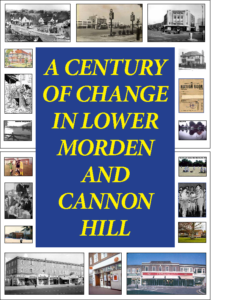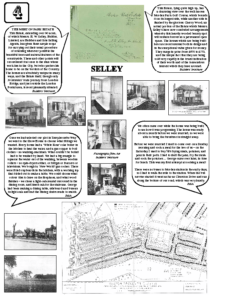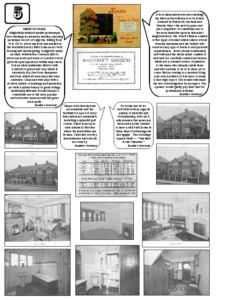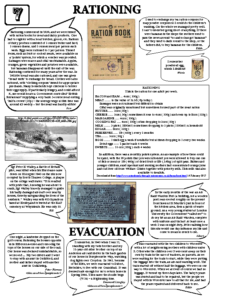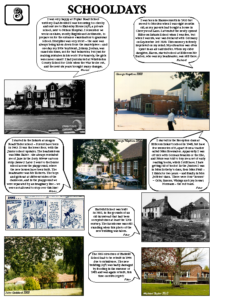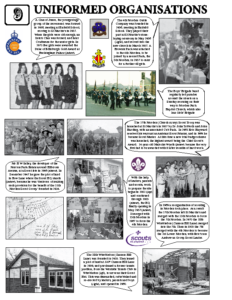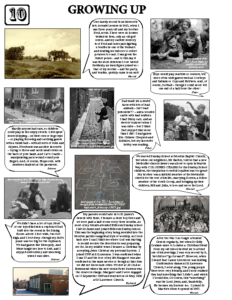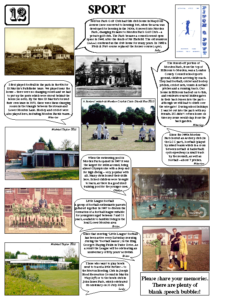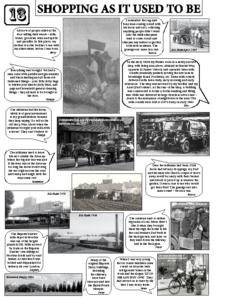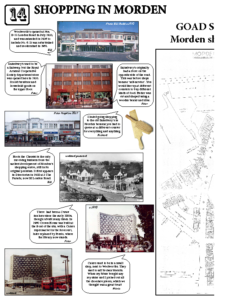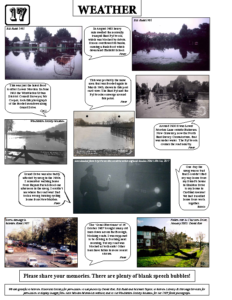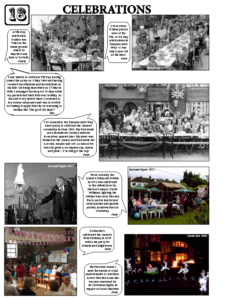4 A Century of Change
In March 2017 Peter Hopkins was asked to create an exhibition on A Century of Change in Lower Morden and Cannon Hill, for an Open Day celebrating the 60th anniversary of St Martin’s Church, Camborne Road, Morden.
In the weeks leading up to the Open Day, members of the congregation were asked to share their memories, which were then displayed within speech bubbles, alongside recollections from members of Merton Historical Society, and relevant photographs.
This exhibition was transferred to Merton Heritage and Local Studies Centre during April 2017, and was also set up at an event at Emmanuel Church, Stonecot Hill, on 1 July 2017.
For those unable to attend any of these events, mini-versions of the original A1 display panels can be viewed by clicking the thumbnails or button above. At the request of copyright holders, these cannot be printed or edited in any way.
Thanks are due to London Borough of Merton for permission to use watermarked images from their Merton Memories photographic archive, to Merton Historical Society members David Roe and Michael Taylor for the use of images from the Society’s Photographic Project, and to those church members and others who contributed other photographs and recollections. Additional images were found online and are individually acknowledged.
BUILDING SUBURBAN MORDEN
Advert from a 1930s’ Guide to Merton and Morden
It was in 1932 that we moved into a council house,
in what was to become the largest housing estate
south of the Thames … the St Helier Estate. It must
have been Utopia for my parents to find themselves
the proud tenants of a three-bedroom council house,
with electric lights which came on at the touch of a
switch, and power points, which meant that my father
could plug in his newly-bought radiogram, housed in
a large freestanding walnut cabinet.
I got a lot of pleasure from it as I grew up, playing my
78rpm records. The radiogram was actually a very
modern innovation as most people had little radios
run by batteries called accumulators, which were
topped up much like our car batteries used to be.
Ron
2
I lived with
my father and
grandmother in
Garth Road, but
we moved into
Tudor Drive after
the War, soon after
the houses were
built.
Gladys
There were two blocks of 19th-
century cottages in Garth Road
towards the London Road end.
There was space between the blocks,
and after the second block, for their
allotments, where most people grew
their own vegetables.
Opposite there were fields as far as you
could see. Further down Garth Road
past the Pyl Brook there was a block of
cottages called Briar Cottages.
In 1935 some land between the brook
and Briar Cottages was sold for
building, and the house where I now
live was built. My husband’s parents
bought it for £5 deposit and £3-1-11 a
month repayments.
Betty
Morden Underground station
opened in 1926, followed by
the arrival of many small
builders, seeking patches of
land for the hundreds of houses
which would be required.
Among them were my father
and grandfather, starting with
a few houses in Poplar Road,
and going on to build more in
Martin Way, Hillcross Avenue,
Arundel Avenue, Leamington
Avenue, Camborne Road, and a
row of shops in Martin Way.
Muriel
MORDEN PARK ESTATE
is a splendid ambition come true—
an ambition of the builders whose
spacious model Estate of picturesque
Tudor houses is in a model situation,
and an ambition of the house -holder
who finds here the perfect house in
natural surroundings and yet within
the easiest reach of town. No wonder
that week after week, month after
month, a stream of new residents
comes to the Estate. Great as it is, it
will be fully taken up ere long. You
who read this booklet should come
quickly, being assured that every house
at Morden Park is a splendid house
and a valuable investment.
Builders’ brochure
Attention is particularly drawn to
the several new Semi-Detached types,
including the striking Earls Court (H3)
design, which attracted great public
interest at the Ideal Home Exhibition.
These types are being erected in very
advantageous positions in Tudor Drive
and Lower Morden Lane, presenting a
rare opportunity to obtain fine value in
a handsome and splendidly situated
Semi-Detached residence.
Full details as to type, price dimensions,
and equipment are in the following pages.
It should be borne in mind throughout
that the Estate is in a fine healthy
situation, slightly elevated, and with its
own Public Park, while it adjoins the wide
stretches of Morden Park which will for
all time remain an open space.
Builders’ brochure
SITUATION
With frontages to the London-Epsom
Road and Lower Morden Lane, the Estate
covers a great extent of gently rising land,
so that the benefit of all the adjoining
open country is enjoyed to the full. While
Town is so easily reached on the one side,
the rolling slopes of Epsom Downs are but
a mile or two away on the other.
Builders’ brochure
THE ESTATE
This is planned on a splendid scale, to be
always a delight to the eye. The houses are of
the picturesque Tudor design, half-timbered
and gabled with pretty lattice bay windows;
the roads are broad, and finely made up, the
trees that will line them will form a pleasant
picture with the trim gardens and their dwarf
walls of brick and stone. A PUBLIC PARK
of no less than twenty acres in extent will be
laid out within the Estate, offering means of
recreation and repose for young and old.
Builders’ brochure
3MORDEN PARK ESTATE
is a splendid ambition come true—
an ambition of the builders whose
spacious model Estate of picturesque
Tudor houses is in a model situation,
and an ambition of the house -holder
who finds here the perfect house in
natural surroundings and yet within
the easiest reach of town. No wonder
that week after week, month after
month, a stream of new residents
comes to the Estate. Great as it is, it
will be fully taken up ere long. You
who read this booklet should come
quickly, being assured that every house
at Morden Park is a splendid house
and a valuable investment.
Builders’ brochure
Attention is particularly drawn to
the several new Semi-Detached types,
including the striking Earls Court (H3)
design, which attracted great public
interest at the Ideal Home Exhibition.
These types are being erected in very
advantageous positions in Tudor Drive
and Lower Morden Lane, presenting a
rare opportunity to obtain fine value in
a handsome and splendidly situated
Semi-Detached residence.
Full details as to type, price dimensions,
and equipment are in the following pages.
It should be borne in mind throughout
that the Estate is in a fine healthy
situation, slightly elevated, and with its
own Public Park, while it adjoins the wide
stretches of Morden Park which will for
all time remain an open space.
Builders’ brochure
SITUATION
With frontages to the London-Epsom
Road and Lower Morden Lane, the Estate
covers a great extent of gently rising land,
so that the benefit of all the adjoining
open country is enjoyed to the full. While
Town is so easily reached on the one side,
the rolling slopes of Epsom Downs are but
a mile or two away on the other.
Builders’ brochure
THE ESTATE
This is planned on a splendid scale, to be
always a delight to the eye. The houses are of
the picturesque Tudor design, half-timbered
and gabled with pretty lattice bay windows;
the roads are broad, and finely made up, the
trees that will line them will form a pleasant
picture with the trim gardens and their dwarf
walls of brick and stone. A PUBLIC PARK
of no less than twenty acres in extent will be
laid out within the Estate, offering means of
recreation and repose for young and old.
Builders’ brochure
3
THE MERTON PARK ESTATE
This Estate, extending over 90 acres,
of which Messrs. H. W. Selley, Builder,
Limited, are Builders and Sole Selling
Agents, has given them ample scope
for carrying out their usual procedure
of retaining wherever possible the
beautiful trees and natural features of the
countryside. These and other points will
recommend it at once to the man whose
work lies in the City, but who prefers his
home to be on the borders of the Country.
The houses are absolutely unique in many
ways, and the Estate itself, though only
30 minutes’ train journey from London
Bridge, and just outside the London
Postal area, is most pleasantly situated.
Builders’ brochure
4
SELLEY
This Estate, lying quite high up, has
a charming view over the well-known
Morden Park Golf Course, which bounds
it on its longest side, while another side is
flanked by the glorious Cherry Wood, an
actual portion of the Estate which Messrs.
Selley’s have now concluded arrangements
whereby this heavily wooded beauty spot
will remain forever as a permanent open
space. The houses which are being built
here are most unusual both in design and
in the exceptional value given for money.
They range in price from £670 to £775,
and the simple fact that they are being
sold very rapidly is the truest indication
of their worth and of the tremendous
interest which they have aroused.
Builders’ brochure
Once we had selected our plot in Templecombe Way
we went to the Show House to choose what fittings we
wanted. Every house had a ‘White Rose’ coke boiler in
the kitchen to heat the water, and a gas copper to boil
clothes – no washing-machines. What couldn’t be boiled
had to be washed by hand. We had a big mangle to
squeeze the water out of the washing, between wooden
rollers – no spin-dryers either, or fridges or freezers or
televisions. We bought a ‘New World’ gas cooker. There
were fitted cupboards in the kitchen, with a working top
that folded out to make a table. We could choose what
colour tiles to have on the fireplaces, and what wood
finishes – we chose a light-oak mantel surround in the
dining room, and limed-oak for the staircase. George
had been making a dining table, sideboard and bureau
in light-oak and had the dining chairs made to match.
Edith
We often came over while the house was being built,
to see how it was progressing. The house was ready
about a month before we were married, so we were
able to bring the furniture in straight away.
Before we were married I used to come over on a Sunday
morning and cook a meal for the two of us – on the
Saturday I used to buy ¾lb frying steak, potatoes, and
peas in their pods. I had to shell the peas, fry the steak
and cook the potatoes … George came over later, in time
for lunch. This was my first attempt at cooking a meal!
There were no buses to Morden station in the early days,
so I had to walk the mile to the station. When the bus
service started it went as far as Churston Drive and ran
along the bottom of our road, which was very handy.
Edith
Photographs from the
builders’ brochure
55
MERTON PARK,
delightfully situated amidst picturesque
surroundings is extremely healthy, enjoying
an unique record of longevity. Rising from
70 to 150 ft. above sea level and nestled in
the beautiful Surrey Hills it has an air both
bracing and health-giving. Delightful walks
abound, Wimbledon Common (800 ft.
above sea level) and some of London’s most
glorious open spaces are within easy reach.
It is an ideal residential district with
a subsoil of gravel and clay which is
extremely dry, free from dampness
and from which all monotony has been
excluded. Clean and well kept with a
modern system of drainage and sanitation,
yet with a sylvan beauty of green foliage,
undulating hills and wooded slopes it
constitutes one of the most popular
and attractive areas around the great
metropolis.
Builders’ brochure
Shops of all descriptions
are available and the
facilities for sport of every
description are unexcelled,
including a splendid golf
course. There is an up-to-
date cinema at Morden
where the latest films can
be seen. Churches of every
denomination and schools
are close by.
Builders’ brochure
It is in these salubrious surroundings
the Merton Park Estate is to be found.
Situated in Westcroft Gardens and
Martin Way—the new by-pass road
just completed—it constitutes one of
the most desirable spots in this select
neighbourhood. Mr. Ward’s Estate consists
of five types of houses which relieve it from
irksome sameness and the builder will
construct any type of house to suit personal
requirements. Every house is extremely
well built and the whole estate consists of
well laid out, carefully constructed homes
which are a constant source of pleasure
to the many who already reside there
and will continue to be so to those yet to
come. Before coming to a decision bring
your own Architect or Surveyor to make
a thorough report. The houses will stand
the test of investigation by an expert. The
sponsor would gladly pay their fees for
professional criticism.
Builders’ brochure
No house can be too
well built both as regards
quality of material and
workmanship, after all it
only means a few pence per
week extra at the outstart
to have a well built house in
these days of advantageous
mortgages. The old adage
repeats itself:— “The Best
is The Cheapest.”
Builders’ brochure
6
WARTIME MORDEN
Total number of bombs dropped from 7th
October 1940 to 6th June 1941 in Lower Morden.
There were daily air raids in 1940
which were replaced in 1941 by continued
nightly air raids. Although there were
anti-aircraft guns on Cannon Hill
Common and Prince George’s Playing
Fields, they only created considerable
noise and were utterly useless. This
period was a distressing time when
bombs were falling, and the following day
observing local houses destroyed, and
customers known to us having lost their
lives. Incidentally, Dad’s shop window
was shattered and, when replaced, again
shattered by a subsequent raid! Another
problem was the cluster of incendiary
bombs, causing fires to break out. These
were countered by various groups set up
as ‘fire wardens’, complete with stirrup
pumps, hoses, buckets, etc, to contain the
fires until the arrival of the fire brigade.
Ken
Morden: High Explosive Bomb 39
Downloaded from http://bombsight.org/explore/
greater-london/merton/lower-morden/ 16 Feb 2017
There were public air raid shelters in
Joseph Hood Recreation Ground, Mostyn
Gardens and other open spaces. However,
they were not generally used as everybody
preferred to shelter in their own homes. On
the outbreak of war, one could obtain an
‘Anderson’ shelter for erection in the back
garden, but they were completely impractical.
They were followed by the ‘Morrison’ shelter
which consisted of a large steel tabletop,
located in the living room and accommodating
4 or 5 people underneath the table. Nearly
everybody preferred sheltering in the
cupboard under the stairs!
Ken
My Dad put an Anderson shelter in the
garden, sunk in the ground, and he put
soil and plants on top of the part that was
exposed. Although I wasn’t very old, I can still
remember the damp smell of concrete. My
Mum told me later, when I was old enough to
understand, that when the siren sounded she
would grab my sister and I – one under each
arm – and take us down the shelter. I think
that was when the Doodle-bugs were coming
over. We were about 3 or 4, me being the elder.
Mavis
There was a blue Police Box (like Dr
Who’s Tardis) in Grand Drive, near
the corner with Lower Morden Lane.
It was next to the siren, which was a
warning of bombs being dropped. The
All Clear was sounded when there was
no more danger. One day the siren
went off when my Mum, sister and I
were going home after shopping. We
had to go in one of our neighbour’s
garages which had a shelter inside, as
we didn’t have time to get home!
Mavis
MerMor_Streets_F_G_22-1 Grand
Drive, Raynes Park, undated:
photo: Trevor Sergeant
Trevor Sergeant (undated)
The Home Guard used to practise every Sunday
morning during the War, on the waste ground where
the new shopping development and flats have just
been built at the corner of Grand Drive and Hillcross
Avenue. They were very smart in uniform and carrying
rifles! They also used the ground where Edinburgh and
Thornton Courts were later built.
The end shop, which lies back, used to be the Post
Office. The siren was on a tall post opposite the Post
Office, so you had to hold your ears! The cows in the
nearby field seemed to get used to the horrible noise!
The Post Office staff were not allowed to use the
shelters, as there was no time to lock everything away!
Gladys
The rubble of a house in Martin Way, Morden,
flattened by enemy bombing in 1940
(c)Wimbledon Borough News [MerMor_World_War_2-5]
After a time we were given a
Morrison shelter which we had
in the front room of the house. It
was like a big steel table. We put
a mattress on the wire mesh that
was the base of it. When we went
to bed we’d go into that. I used
to put the two children in. It was
a bit scary. During the raids, we
could hear the guns on Cannon
Hill Common. Jeanne sometimes
asked me, “Mummy, why are you
shaking?” and I would reply, “I’m
cold! You’ve got all the blankets”!
Edith
After a brief lull in 1943, we had
the arrival of the ‘fly bomb’ in 1944.
This was a device resembling a small
aircraft which, on the engine stopping,
would descend rapidly, causing
immense destruction on landing. I
recall an occasion when one of these
devices cut out as it flew overhead as
I was with several others in Mostyn
Gardens. It descended towards us
but finally landed in Martin Way,
causing considerable casualties to the
occupants of the house.
Ken
Our house was damaged when a doodle bug
exploded in neighbouring Northway. but the war
also had its excitement for a small boy – collecting
shrapnel and watching all sorts of aircraft as well as
doodle bugs. The war meant rationing and shortages.
Richard
George was an air-raid
warden during the first part
of the war, stationed at the top
of our road. Whenever there
was a red alert he used to pop
home and tell me, and I would
wrap Jeanne up in a big
blanket ready to take her down
to the Anderson shelter when
the siren went. We had two
Anderson shelters together at
the end of the garden to make
it bigger and shared it with
the next-door neighbour and
her two children.
Edith
A house in the next road,
facing some backing onto ours,
had to be re-built. The family in
that house were killed – a husband,
wife and baby. Part of the house
next door to it also had to be
re-built. A piece of the brickwork,
about 8 bricks square, hit the corner
of our air-raid shelter, but we were
alright. Jeanne cried because the
dust went in her eyes. Also there was
a big crater in the road in front of
our house. We had damage through
the front bedroom roof and had to
have rooms painted and re-papered
to clear up the war damage.
Edith
Rationing commenced in 1939, and we were issued
with ration books for meat and dairy products. One
had to register with a local butcher, grocer, etc. Rations
of dairy produce consisted of 2 ounces butter and lard,
2 ounces cheese, and 2 ounces meat per person each
week. Eggs were rationed to 1 per person. Tinned
items, such as fruit or cooked meats, were available on
a ‘points’ system, for which a voucher was provided.
Sausages were scarce and offal unobtainable. Apples,
oranges, green vegetables and potatoes were available,
but bananas disappeared until the end of the war.
Rationing continued for many years after the war. In
1953/54 bread was also rationed, and one was given
‘bread units’ to exchange for bread. Clothes were also
rationed, with ‘clothing coupons’ issued for appropriate
purchases. Many households kept chickens to bolster
their egg supply. If particularly hungry, and could afford
it, one would locate a Government-controlled ‘British
Restaurant’ supplying a very basic 3-course meal costing
‘half a crown’ (25p) – the average wage at this time was
around £3 weekly – but the meal was hardly edible!
Ken
http://i.dailymail.co.uk/i/pix/2010/07/09/article-
1293468-00127C6400000258-428_468x286.jpg
RATIONING
This is the ration for one adult per week.
7
BACON and HAM … 4ozs ( 100g )
MEAT …….. to the value of 1s.2d ( 6p today )
Sausages were not rationed but difficult to obtain
Offal was originally unrationed but sometimes formed part of the meat ration
BUTTER ……. 2ozs ( 50g )
CHEESE ……. 2ozs ( 50g ) sometimes it rose to 4ozs ( 100g ) and even up to 8ozs ( 225g )
MARGARINE …… 4ozs ( 100g )
COOKING FAT ….. 4ozs ( 100g ) often dropping to 2ozs ( 50g )
MILK …….. 3 pints ( 1800ml ) sometimes dropping to 2 pints ( 1200ml ) a household
SUGAR …….. 8ozs ( 225g )
PRESERVES …… 1lb ( 450g ) every 2 months
TEA ……… 2ozs ( 50g )
EGGS …….. 1 shell egg a week if available but at times dropping to 1 every two weeks.
Dried eggs —– 1 packet each 4 weeks
SWEETS …….. 12 ozs ( 350g ) each 4 weeks
In addition, there was a monthly points system. As an example of how these could
be spent, with the 16 points that you were allocated you were allowed to buy one can
of fish or meat or 2lb ( 900g ) of dried fruit or 8lb ( 3.6kg ) of split peas. Babies and
younger children, and expectant and nursing mothers had concentrated orange juice
and cod liver oil from Welfare Clinics together with priority milk. This milk was also
available to invalids.
Downloaded from http://www.astonbrook-through-astonmanor.co.uk/homefront.html 14 February 2017
In the early months of the war an Air
Raid Warden Post (a building, not a wooden
post) was erected roughly on the present
front lawn at St Martin’s just in front of
the kitchen area, then a patch of waste
ground. As a very young student at London
University the Government “called me” to
do my bit as an Air Raid Warden, complete
with uniform and tin hat! At least once a
week I was on night duty, little realising how
this site would one day influence my life and
come to mean so much to me.
Albert
I remember, in 1940 when I was 11,
standing with my twin brother and my
12-year-old elder brother on top of an
Anderson air raid shelter in the back garden
of our house in Templecombe Way, watching
dog fights over Croydon. In 1941, because
of the Blitz, we were evacuated to Didcot,
Berkshire, to live with our Granddad. It was
deemed safe enough for us to return home in
Spring 1944. Then came the doodle bugs
(V-1s) – a frightening time.
Desmond Langley
<bbc.co.uk/ww2peopleswar>
I was evacuated with the two children to Worcester
with a lot of neighbouring mothers with children under
5. Otherwise the children over 5 were sent away on their
own by train in the care of teachers, no parents. As we
were waiting for the train to start, while they were putting
the luggage into the train, an air-raid warning went. The
train started off without half the luggage. We were on our
way to Worcester. When we arrived of course we had no
luggage. It turned up three days later. The baby’s pram
was dented and had to be repaired, but the people we
stayed with in Worcester saw to all that for me, and had
the pram repaired and delivered back to me.
Edith
RATIONING
I remember
powdered egg,
which I disliked!
Mavis
I used to exchange my tea ration coupons for
soap powder coupons so I could do the children’s
washing. On the whole we managed pretty well.
I can’t remember going short of anything. If there
were bananas in the shops the mothers used to
pass the news around “so and so has got bananas”
and they used to dash round to the shop, or the
fathers did, to buy bananas for the children.
Edith
Sgt Peter K Walley, a Battle of Britain
pilot, was killed when his Hurricane came
down on 18 August 1940 on the site now
occupied by South Thames College. A plaque
on the college wall states: “It is recalled
with pride that, knowing he was about to
crash, Sgt Walley bravely managed to guide
his badly damaged aircraft over nearby
houses, thereby safeguarding the lives of the
residents.” Walley was with 615 Squadron
based at Kenley,and is buried at the RAF
cemetery at Whyteleafe. He was only 20.
Bill
One night, a landmine dropped on the
golf course, flattening the houses opposite
us in Hillcross Avenue and removing the
tops of the houses on our side of the road.
Our house was declared uninhabitable, so
we moved … My two sisters and I went
to stay with an aunt in Guildford, and
mother and father stayed with another
aunt in Godalming.
Peter Ramsey
<bbc.co.uk/ww2peopleswar>
EVACUATION
8
SCHOOLDAYS
I started in the Infants at Aragon
Road/Tudor school – it must have been
in 1943. It was the lower floor, with the
Junior school upstairs. The headmistress
was Miss Baker – she always reminded
me of Jane in the Daily Mirror cartoon
strip (below)! Later I went to the Senior
school across the playground, where
the new houses have been built. The
headmaster was Mr Roberts. The boys
and girls sat at different sides of the
classroom, and in the playground we
were separated by an imaginary line – we
were not allowed to stop over this line!
Mavis
I was very happy at Poplar Road School
until my Dad decided I was becoming too cheeky
and sent me to Blakesley House (left), a private
school, next to Nelson Hospital. I remember we
wrote on slates, mostly English and Arithmetic, to
prepare us for the entrance examination to grammar
school. Discipline was very strict – the cane was
always being taken down from the mantelpiece – and
one day my little boyfriend, Johnny Jordan, was
caned six times, not for bad behaviour, but just for making mistakes in his work! Fortunately, the girls
were never caned! I had just started at Wimbledon
County School for Girls when the War broke out,
and the next six years brought many changes.
Muriel
I was born in Hammersmith in 1933 but
moved to Morden when I was eight months
old, as my parents had bought a house in
Cherrywood Lane. I attended the newly opened
Hillcross Infants School when I was five, but
when I was six, war was declared with Germany
on September 3rd 1939. This memory is firmly
imprinted on my mind. My education was often
spent in an air raid shelter. When my elder
daughter, Karen, started school at Hillcross Mr
Barker, who was my headmaster, was still there.
Richard
I started in the Reception class at
Hillcross Infant’s school in 1948, but have
few memories of it, apart from a teacher
called Miss Bowmaker. Apparently I was
off sick with German Measles or the like,
and Mum was told to buy me a set of early
reading books, which I still have. I hate
getting rid of books! In the Juniors I was
in Miss Sotheby’s class, then Miss Field –
I think for two years – and finally in Mrs
Jeffries’ class. There were four ‘houses’
– Celts, Saxons, Vikings and (my house)
Normans – the red team.
Peter
George Hopkins 2000
George Hopkins 2000
John Goddard 2000
Hatfeild School was built
in 1952, in the grounds of an
old farmstead that had been
occupied since at least the 13th
century. The farmhouse was still
standing when this photo of the
new building was taken.
Peter
The 1952 structure of Hatfeild
School had to be rebuilt in 1994
due to subsidence. The new
building (left) was badly damaged
by flooding in the summer of
1981 and was again rebuilt, this
time on stilts (right)!
Peter
Michael Taylor 2012
UNIFORMED ORGANISATIONS
Mr H W Selley, the developer of the
Merton Park Estate around Hillcross
Avenue, at a Scout fete in 1946 (above). In
December 1947 he gave the plot of land
in Bow Lane where the Scout HQ stands
(below), because he was ‘desirous of making
such provision for the benefit of the 12th
Morden Scout Group’ founded in 1934.
With the help
of leaders, parents
and scouts, work
to prepare the site
began in 1951 (top)
and continued
through 1955
(above), the HQ
finally opening in
May 1957 (below).
It merged with
15th Morden in
1967 to form the
4th Morden.
The 17th Morden (Church Army) Scout Troop was
launched at St Martin’s in 1957 by Dr John Tebboth and John
Harding, with an associated Cub Pack. In 1962 Eric Hayward
received his warrant as Assistant Scout Master, and in 1964 he
became Scout Master. At this time a new trial badge scheme
was launched, the highest award being the Chief Scouts
Award. 14-year-old Malcolm Wyeth (below) became the very
first lad to be awarded with it after months of hard work.
In 1969 a reorganisation of scouting
in Morden took place. As a result
the 17th Morden left St Martin’s and
merged with the 13th Morden to form
the 7th Morden. In 1970 the 18th
Wimbledon (Cannon Hill Lane) merged
into the 7th. Then in 2005 the 7th
merged with the 4th Morden to become
the 1st Lower Morden, with Eric’s son
Andrew as Group Scout Leader.
The 18th Wimbledon (Cannon Hill
Lane) was founded in 1935. They leased
a plot of land at 320B Cannon Hill Lane
in 1959, and purchased a former tennis
pavilion, from the Westside Tennis Club in
Wimbledon (left), to serve as their Scout
Hut. This was dismantled, refurbished and
re-erected by leaders, parents and boys
(right), and opened in 1960.
9
A Clan of Junos, the youngest age
group of the movement, was formed
in 1956, meeting at Hatfeild School,
moving to St Martin’s in 1957.
When the girls were old enough, an
Inters Clan was formed, and later
Craftsmen for the senior girls. In
1972 five girls were awarded the
Duke of Edinburgh Gold Award at
Buckingham Palace (below).
The 4th Morden Guide
Company was founded in
1956, meeting in Hatfeild
School. They played their
part at St Martin’s stone-
laying ceremony in May 1956
(right), and moved into the
new church in March 1957. A
Brownie Pack was attached
to the 4th Morden, to be
joined by a second Pack, the
5th Morden, in 1957 to cater
for a further 48 girls.
The Boys’ Brigade band
regularly led parades
around the streets on a
Sunday morning on their
way to Morden Park
Baptist Church, which also
has Girls’ Brigade
My parents would take us to St James’s
church with them. I became a choir boy there and
we were paid a half crown every three months. As
most of my friends attended Hillcross Sunday school
I left St James and joined Hillcross Sunday school.
This was the beginning of my being moulded into the
Morden parish evangelical style of worship. As I look
back now I can I think see where God was starting
to mould me into the direction he was preparing
me for. In my middle teens I became a Christian by
accepting Jesus Christ as my personal Saviour. I
joined YPF at St Lawrence. I was confirmed when
I was 17 and the love of my life Margaret was also
confirmed at the same service or though at that time
we did not know each other. We met at 20 Club at
Emmanuel where the new curate Peter Dawson was
the curate in charge. Margaret and I were engaged
on 11 September 1956 and married on 24 May 1958
at St Lawrence Church.
Richard
10
downloaded Feb 2017 from
http://2.bp.blogspot.com/
Hardly anyone had cars, so children
could play in the empty streets. Girls spent
hours skipping – on their own or in groups
– or playing throwing and catching games
with a tennis ball – with all sorts of rules and
rhymes. Fivestones was another favourite
– trying to throw and catch small cubes on
the back of your hand. And Cat’s Cradle –
manipulating yarn wound round your
fingers. And, of course, Hopscotch, with
numbers chalked on the pavement.
Jeanne
We didn’t have a lot of toys. Most
of our toys fitted into a cupboard Dad
built into the recess in the Dining
Room -about 3 foot wide, two foot
high, and 1 foot deep -though my doll’s
pram was too big for the cupboard.
We had games like Monopoly. And
Mum taught me how to knit, and I
enjoyed embroidery and smocking
when I was older.
Jeanne
downloaded Feb 2017 from http://collections.
museumvictoria.com.au/
GROWING UP
We started Sunday School at Morden Baptist Church,
but when our neighbour, Mr Barber, told us that a new
Methodist church (below) was about to open in Martin
Way with COLOURED CHAIRS for the Sunday School
children, the temptation to switch loyalties was too great!
My brother was a faithful member of the Methodist
church for the rest of his life, marrying Doreen, a fellow
member of the Youth Group, and bringing up their
children, Bill and Julia, to love and serve the Lord.
Muriel
Our family moved from Isleworth
into Arundel Avenue in 1931, when I
was three years old and my brother
Fred, seven. There were no houses
behind us then, only an old golf
course, and my earliest memory
is of Fred and some pals lighting
a bonfire in one of the bunkers
and sending me indoors to collect
potatoes to roast. I was given the
tiniest potato – and to this day it
was the most delicious I ever tasted!
Suddenly, an irate figure joined us –
that of my mother – and the party,
and bonfire, quickly came to an end!
Muriel
Boys would play marbles or conkers, but
more often wide games such as Cowboys
and Indians or Cops and Robbers. And, of
course, football – though I could never tell
one end of a ball from the other!
Peter
Dad made me a model
farm with lots of lead
animals – isn’t lead
poisonous?!! – and a wooden
castle with lead soldiers.
I had Dinky cars, and an
electric train set when I
was older – but I think
Dad enjoyed that more
than I did! I had games
like Chinese Chequers and
Solitaire, but my favourite
hobby was reading.
Peter
downloaded Feb 2017 from
http://manchesterhistory.net/
LONGSIGHT/GAMES/ballgame.jpg
downloaded Feb 2017 from https://
timrgill.files.wordpress.com/2013/05/
hopscotch_drawing-13625.jpg
downloaded Feb
2017 from https://s-
media-cache-ak0.
pinimg.com/
After the War I no longer attended
Church regularly, but when Dr Billy
Graham came to London a Christian friend
from my old school invited me to attend
one of his meetings. I was very moved by it,
but did not “go forward”. However, when
I heard that Canon Livermore was holding
Confirmation classes at St Lawrence
Church, I went along. The young people
there were very friendly, and I soon realised
they had something that I didn’t, and which
I would like. Of course, this “something”
was the Lord Jesus, and, thankfully,
He became my Saviour too. I joined St
Martin’s when it opened in 1957.
Muriel
Partial / Incomplete Date c.1930 Area Merton Park Copyright 1 Mrs. I.
Holbown, Picture Reference MerMor_15_14-1 Original Format Photo
11
MerMor_23_5-6 Morden Park, Morden: USAF Band September 1999 (c)
Croydon Times Harold and I used to attend
the Wimbledon Welsh Society’s
dinner and dance, which was
held for many years in the
King’s Room at the rear of the
Crown inn.
Gill
One thing I looked forward to
was the Saturday morning children’s
film show at the local cinema. How we
all enjoyed those Saturday morning
films, usually a double bill, firstly Flash
Gordon, the heroic spaceman. It always
left off at a cliff-hanger situation, which
meant having to go the following week
to find out what happened. In the
interval the organ played for a singsong,
the words of which came up on the
screen. One song was their own jingle
and I’ve forgotten most of the words,
but I remember the bit I was meant to
remember, which was ‘Every Saturday
morning at the O-de-on’.
Ron
Music in the Park
???
The Crown inn at Morden was a
lovely pub and had a huge fireplace
and in the winter would have a
huge log fire lit. (Note the old blue
police box in the foreground.)
Mavis
The Central Ward Residents’
Association Club in Ashridge
Way
???
I have always loved reading,
so I was a frequent visitor to the
old library at the corner of Bow
Lane and Lower Morden Lane. It
opened here in 1946, housed in a
formerWW2 Civil Defence depot.
It closed around 2000. and has
recently been demolished prior to
redevelopment.
Peter
Michael Taylor 2011
Michael Taylor 2013
Peter Hopkins 2011
Morden is fortunate to have so
many public open spaces, such as
Morden Park (right), created as a
wealthy merchant’s country estate in
the late 18th century out of former
farmland. Cannon Hill Common
(below) was also formed from the
parkland of a rich man’s country
estate, and was never common land,
but now can be enjoyed by all.
Peter
LEISURE
David Roe 2005
photo from Messrs Selleys’ brochure Cherry Wood has developed
over the centuries, having been
abandoned as arable land in
the 14th century and gradually
reverting to scrubland. Many of
the larger oak trees are 200 years
old. The wood survived within
Merton Park Golf Course, and
was given to Merton and Morden
District Council by the developers,
Messrs W H Selley, in the 1930s as
a permanent open space.
Peter
Photo Bill Rudd1970
MerMor_23_5-12 Morden Park, Morden: Swimming Pool March 19731973
1969/70
Michael Taylor 2011
Since that meeting ‘Little League’ football
has been active every Saturday morning
during the ‘football season’, in the King
George’s Playing Fields in Tudor Drive. As
a result the League will be celebrating an
anniversary of fifty years’ activities.
Brian
Little League football
A group of football-enthusiastic parents
gathered together in 1967 to discuss the
formation of a football league suitable
for youngsters aged between 7 and 12
years, available to families living in the
local Lower Morden area
Brian
Those who want to play bowls
need to travel a little further – to
the Merton Bowling Club in Joseph
Hood Recreation Ground in Martin
Way (left) or to the bowls club in
John Innes Park, which celebrated
its centenary on 31 July 2009.
Lesly
1971/72
12I first played football in the park in the 60s for St Martin’s Pathfinder team. We played near the
house – there were no changing rooms and we had
to put up the posts which were stored behind the
house (no nets). By the time St Martin’s formed
their own team in 1970, there were these changing
rooms in the triangle between the stream and
Lower Morden Lane. Hockey and cricket were
also played here, including Morden Parish teams.
Maurice
Michael Taylor 2011
SPORT
Merton Park Golf Club had this club house
in Maycross Avenue (now converted to housing)
but, when the area was developed for housing in
the 1930s, it moved into Morden Park, changing
its name to Morden Park Golf Club – a private
golf club. The Park became a council-owned open
space in 1946, after the death of Mr Hatfeild. The
old mansion (below) continued as the club house
for many years. In 1968 a Pitch & Putt course
replaced the former course (right).
Judy
A Juniors’ match at Morden Cricket Club: David Roe 2015
Gladys
Bull 189
The fenced-off portion of
Morden Park, from the top of
Hillcross to Morden, was a London
County Council school sports
ground, children arriving by coach.
They had football, cricket and hockey
pitches, cricket nets, tennis & netball
pitches and a running track. Our
house in Hillcross backed on to this,
and residents created hidden gates
in their back fences into the park –
although we still had to climb over
the wire gate! During school holidays
I was let out into the park with my
friends. If I didn’t return home on
time my mum would clap from the
back garden.
Maurice
Since the 1960s Morden Park
hosted an Archery club (in the
LCC part), korfball (played by
mixed teams which is a cross
between netball & basketball)
cyclo-speedway (a small track
by the mound), as well as
football – about 7 pitches.
Maurice
Please share your memories.
There are plenty of
blank speech bubbles!
13
All sorts of people called at the
door selling their wares – milk,
bread, groceries, wine and spirits
and paraffin. In this photo, my
mother is at the butcher’s van with
my eldest sister, before I was born.
Betty
everything was brought. We had a
man come with paraffin and gas mantles
and black-leading and all those old-
fashioned things – your little dolly-bags
to whiten your sheets (dolly blue), and
pegs and household general cleaning
things – they all used to be brought to
the door.
Gladys
In the early 1930s my Father took on a newly-erected
shop with living area above, situated in martin Way,
opposite St James’ church, and operated three milk
rounds (manually pushed) serving the new area in
Monkleigh Road, Northway, etc. These milk rounds
delivered milk twice daily, early morning and early
afternoon. The shop was serviced by my mother and my
aunt (Dad’s sister). at the rear of the shop, a building
was constructed to house a bottle-washing and filling
unit. milk was delivered in large churns at about 3am –
much to the annoyance of neighbours in the area! The
milk rounds were sold to Job’s Dairy in early 1940.
Ken
The milkman used to leave
his cart outside the Beverley
where the big elm tree was and
if the man was in the Beverley
too long the horse would drag
the cart right across the road
and stamp and neigh until the
man came out!
Madeline
many of the
original Express
Dairy buildings,
including
the chimney,
have been
incorporated into
the Baitul Futuh
Mosque.
Peter
SHOPPING AS IT USED TO BE
I remember the rag-and-
bone man coming round with
his horse and cart, collecting
anything people didn’t want.
Also the knife-sharpener
used to come round and
sharpen any knives or garden
tools such as shears. The
greengrocer came in a van.
Mavis
Bill Rudd April 1969
Downloaded from http://www.friendsofhoneywood.co.uk/
Memories.htm Jan 2017
once the milkman had been, if his
horse had left any droppings, my Dad
and his mate who lived a couple of doors
away would be ready with their bucket
and shovel to pick it up to manure the
garden. It was a race to see who would
get there first! The greengrocer also
came round – but in a van.
Mavis
The coalman used to deliver
big sacks of coal. mum didn’t
like it when they brought
them through the house to fill
the coal bunkers Dad built in
the back garden, and later on
they went down the sideway
and in the back gate.
Peter
Downloaded from Pinterest
Jan 2017
When I was very young
the ice cream salesmen came
round on tricycles with
refrigerated boxes on the
front and the slogan ‘STOP ME AND BUY ONE. They
had moved on to vans by the
time I was in my teens.
Peter
The milkman had his horse,
which is of great amusement
to my grandchildren because
they keep saying ‘Do tell us the
old story, Nan, about when the
milkman brought your milk with
a horse! ‘They can’t believe it!
Gladys
Bill Rudd 1956
Bill Rudd 1970
The express Dairies
milk depot in Morden
was one of the largest
plants in UK. milk arrived
by train on the express
Dairies’ own sidings at
Morden South and by road
tanker. at Morden it was
bottled and dispatched for
delivery all over London.
Stephen
Desmond Bazley 2004
undated postcard
c.1970
14
SHOPPING IN MORDEN
Photo Bill Rudd c.1970
Woolworth’s opened at Nos.
8-12 London Road in July 1933,
and was extended in 1936 to
include No. 6. It was refurbished
and modernised in 1962.
Bill
Sainsbury’s used to be
a Safeway, but the Royal
arsenal Cooperative
Society department store
was opened here in 1932.
It sold furniture and
household goods on
the upper floor.
Peter
MerMor_28_11-1 Safeway, London Road undated, formerly RACS, opened
September 1932
undated
boots the Chemist is the only
surviving business from the
earliest development of Morden’s
shopping centre, still in its
original premises. It first appears
in Directories in 1928 at 3 The
Parade, now 58 London Road.
Bill
There had been a Crown
inn here since the early 1800s,
though rebuilt many times. In
1960 Crown House was built at
the front of the site, with a Caters
supermarket in the forecourt,
later replaced by Presto, where
the library now stands.
Peter
undated
Caters used to be in a small
shop, next to Woolworths. They
used to sell broken biscuits.
When my mum bought any
my sister and I picked out all
the chocolate pieces, which we
thought was a great treat!
Mavis
I hated going shopping
to the old Sainsbury’s in
Morden because you had to
queue at a different counter
for everything and anything.
Richard
Peter Hopkins 2017
GOAD S
Morden shops
Sainsbury’s originally
had a store on the
opposite side of the road.
This was before shops
became ‘self-service’. you
would line up at different
counters to buy different
kinds of food. butter was
cut and shaped using a
wooden beater and slice.
Peter
MerMor_8_1-61 London Road, Morden: Civic Centre and Supermarket
undated
GOAD
Survey of
Morden
shops
1975
Survey of
hops 1975
March
1975
When I was 15 I worked I
worked half day on Saturdays at
Hawes Department store, selling
baby clothes and children’s
clothes. I loved it. I spent my first
Saturday’s wages on a Cream
Puff face powder from the Co-op
across the road.
Jeanne
15
MerMor_OS_Morden,_Morden_Park,_Morden_Hall_T1-5 London Road,
Morden: Junction at Abbotsbury Road & Roundabout with Morden Hall Road
Looking towards Morden Hall Park and Gate Lodge with Hawes Department
store and ABC tea rooms to the right in Abbotsbury Road. undated
MerMor_28_5-1 Gilbey Menswear
resited 1998 at 32 Crown Lane, next
to Lansdales Florists (photo c.2002)
(closed 2008)
Gilbey’s opened at 11 London Road
in 1934. It specialised in accessories
to the men’s outfitters – jerseys,
pullovers, shirts, ties, belts, underwear,
socks and handkerchiefs. It moved to
32 Crown Lane [right] in 1998.
Bill
Morden got its first post office in 1891 in Central Road. The next
was in London Road, by 1903, in one
of the new-built Crown shops near the old Crown inn. In 1928 it was at
1 Mellish’s Terrace, a corner shop
in London Road. The office at No.25
Abbotsbury Road opened in 1958.
It took up two shop fronts, leaving
access to Flat 27 on the front right-
hand side. The large space at the
back of the post office allowed vans
carrying mail and security vehicles
carrying money a safe place that
could be secured.
Bill
19 and 21 Abbotsbury Road, Morden, December 1970 (Bill Rudd)
opened in 1932 as the
independent Morden Cinema,
it was part of the Odeon group
by 1937. It had become a B&Q
store by 1977 when this advert
appeared. The site was later redeveloped, Iceland opening
here on 18 October 1994.
Bill
25 Abbotsbury Road in 1992 (Bill Rudd)
7-19 London Road June 1971 (Bill Rudd)
(c.2002)
undated
Bill Rudd, 1970
my Dad bought a
Silvercross pram for my
first daughter from this
pram shop in Abbotsbury
Road, in 1961. It was
then used for my second
daughter in 1964. Then a
friend borrowed it when
I had finished with it, and
then my sister had it for her last child in 1970.
Mavis
Please share your memories.
There are plenty of blank
speech bubbles!
MerMor_28_8-1 Ladbrokes, J D Wetherspoon & Sony, Aberconway
Road c.2002
c.2002
16
SHOPPING IN GRAND DRIVE
MerMor_6_7-30
Grand Drive, Lower Morden: Shopping Parade
being built c.1930
In the 1960s the Co-op
used to be in three shops – a
grocery, a butchery and a
greengrocery. There were no
shops between the Co-op and
what is now the hairdresser.
This land was originally
bought to build a Baptist
church, which they subsequently swapped for their current site by the
roundabout.
Maurice
MerMor_6_7-15 Grand Drive, Raynes Park: Opening of
the RAC Store c.1939 (c) Marilyn Bartlett
Grand Drive, Lower Morden:
Shopping Parade being built c.1930
Opening of the RAC Store Grand
Drive c.1939 © Marilyn Bartlett
I used to work in Helene’s in
Grand Drive, which sold clothes
from baby size up to adult
women. We also sold slippers,
knitting wool and haberdashery.
It was a very friendly shop and
we had many customers who
came in to chat, as well as to buy.
Mavis
When my sister and I were
young the Co-op used to issue
different shaped tin checks
which were given every time
one spent money.
Mavis
MerMor_Streets_F_G_22-1 Grand Drive, Raynes Park, undated:
photo: Trevor Sergeant
Trevor Sergeant (undated)
John Goddard 1999
Chris Scoffield Starting from the
roundabout there was
a newsagent similar to
today’s shop but including
the Post office, then Holes
the baker, Charles the
ladies’ hairdresser, the café,
Helene’s the drapers, an
independent greengrocer,
a chemist, and a hardware
shop with yard behind.
at the Cannon Hill Lane
end was Lovibonds the off-
licence, a newsagents called
Cannon Hill Library, Paul
Electrics, and the toy shop
Bonadventure.
Maurice
John Goddard 1999
my sister and I used to play
shops with these checks. I think
they were like points one gets
nowadays with loyalty cards,
paid towards a dividend.
Peter
There was an off-
licence, which sold all
kinds of drinks. It was
in the Beverley car park
in Lower Morden Lane,
and is now a firework
shop. Shops weren’t
allowed to sell alcoholic
drinks in those days.
Mavis
The end
shop, which lies
back, used to be
the Post office,
where I worked.
Gladys
Bill Rudd 1981
Wimbledon Society Museum
This was just the latest flood
to affect Lower Morden. In June
1903 the Wimbledon Urban
District Council Surveyor, Mr
Cooper, took this photograph
of the flooded meadows along
Grand Drive.
Cyril
WEATHER
In August 1981 heavy
rain swelled the normally
tranquil East Pyl brook,
which was blocked by debris.
It soon overflowed its banks,
causing a flash flood which
devastated Hatfeild School.
Peter
This was probably the same
area that was flooded again in
March 1905, shown in this post
card view. The East Pyl and the
Pyl brooks converge around
this point.
Peter
MerMor_6_7-3
Grand Drive was also badly
affected by smog in the 1950s.
I remember walking home
from Raynes Park School one
afternoon in the smog. I couldn’t
see where the road was! Dad
took a wrong turning cycling
home from New Malden.
Peter
downloaded from http://www.bbc.co.uk/news/uk-england-london-20615186
Jan 2017
17
MerMor_9_1-12 Lower Morden Lane: Battersea New Cemetery c.1930Bill Rudd 1981
Around 1930 it was Lower Morden Lane outside Battersea
New Cemetery, now the North
East Surrey Crematorium, that
was under water. The Pyl brook
crosses the road nearby.
Peter
One day the
smog was so bad
that I couldn’t find
my way home from
my friend’s house
in Shaldon Drive
to my house in
Cardinal Avenue!
We had travelled
home from work
together.
Mavis
MerMor_11_4-8 Morden Road: Storm Damage: c.1987
The ‘Great Hurricane’ of 16
October 1987 brought many old
trees down across the Borough,
blocking roads. I was supposed
to be driving to Dorking next
morning, but my road was
blocked at both ends! Other
trees have fallen in more recent
storms.
Peter
Storm damage in
Morden Road 1987
Fallen tree in Churston Drive,
January 2005: David Roe
Please share your memories. There are plenty of blank speech bubbles!
We are grateful to Merton Historical Society for permission to use photos by David Roe, Bill Rudd and Michael Taylor, to Merton Library & Heritage Services for
permission to display images from their Merton Memories website, and to the Wimbledon Society Museum for the 1903 flood photograph.
AVE-Day
celebration
bonfire was
built on the
waste ground
where St
Martin’s was
later to be built.
Sheila
18
I do remember the Templecombe Way
street party to celebrate the Queen’s
coronation in June 1953. My Dad made
me a Household Cavalry uniform
from silver painted lino! My sister was
dressed as the Queen, and Dad made her
a crown, sceptre and orb. At school we
were all given a coronation cup, saucer
and plate – I’ve still got the cup!
Peter
I was unable to celebrate VE Day, having
joined the Army on 3 May 1945 and having
received vaccinations and inoculations on
the 8th! On being demobbed on 27 March
1948, I managed the shop for 10 days while
my parents had their first-ever holiday. At
the end of my demob leave I returned to
my former employers and was in trouble
for failing to apply directly on returning to
civilian life! The good old days??
Ken
More recently, the
Queen’s Diamond Jubilee
in 2012 was celebrated
at the official level by
Merton’s mayor, David
Williams, lighting the
Jubilee beacon in Morden
Park, and in less formal
street parties and garden
parties, as shown here in
Greenway.
Peter
Michael Taylor 2012
Michael Taylor 2012
Celebrating the Queen’s 90th
birthday at St Martin’s
David Roe 2006
CELEBRATIONS
I’m not sure
if these photos
were of the
VE- or VJ-Day
celebrations in
Templecombe
Way – I was
only a year old
at the time!
Peter
But Morden doesn’t need the excuse
of royal anniversaries to celebrate.
Lower Morden Lane has become
renowned for its Christmas lights, in
support of local charities.
Peter
 MERTON HISTORICAL SOCIETY
MERTON HISTORICAL SOCIETY 